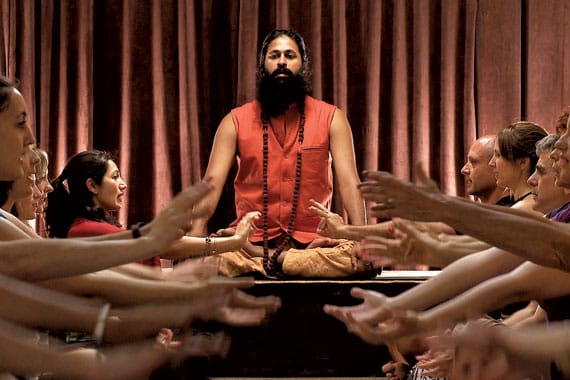Outside of The Dark Knight Rises, The Avengers, and other summer blockbusters, one of the season’s most talked-about films is Kumare: The True Story of a False Prophet. Read a review of this unusual documentary and its unique view of spiritual teachers and students.

Brooklyn-based filmmaker Vikram Gandhi likens his new genre-bending documentary Kumaré to a Zen koan. Followed by a film crew, Gandhi grows out his hair and beard, dons an accent, and becomes a “fake guru” he calls Kumaré. Vikram then has his character visit suburban Arizona. The aim isn’t just to trick people, but to teach people who think they need a guru that all spiritual leaders are actually illusions — and the only real guru is within.
“The reason for making the film was in a way propaganda — exposing something that seems real to me and true,” Gandhi says now, as the film continues to open in theaters around the U.S.
But it’s not propaganda without humor. “I didn’t want to say it isn’t a joke,” Gandhi says. “It is a joke. It’s just a serious joke. It’s not a movie that’s just a spiritual quest, it’s also a skeptic’s quest.”
Gandhi’s skepticism is justified: today, yoga is not just a discipline but also a $5 billion-a-year industry. And the gurus Gandhi encounters at the beginning of his film are preoccupied with seducing young women, deriving relevance from a historical tradition from the other side of the world, and “out-guru(ing) one another.”
But the higher the pedestal these gurus put themselves on, the farther they get from the one anchor of spiritual experience Gandhi knows to be true and authentic — his tiny, unassuming grandmother, who performs Hindu morning rituals on the kitchen floor and to whom the film is dedicated.
Kumaré is a deceptively sweet film, executed to elicit genuine sympathy and compassion for its core cast of characters, and to bring the viewer on an entertaining and suspenseful ride. But it does pull the rug out from under gurus and students who believe in supernatural powers or that a guru’s supposed closeness to God give him a pass on bad behavior and poor intentions.
Kumaré is also at times hilarious, and at other times uncomfortable, to watch. (Thus, the many comparisons to Borat.) Kumaré’s “teachings” are so explicit about the inauthenticity of the whole premise of a guru, and his actions are sometimes so outrageous that you expect the whole thing could fall apart at any moment.
It doesn’t, of course, and the entire Kumaré experiment leads up to a final teaching called “The Great Unveiling.” By that point, you actually feel sympathetic towards Kumaré’s students — even if they do look ridiculous with a tika in the shape of a penis painted on their foreheads — and anticipate the Great Unveiling with an odd mix of morbid fascination and naive hope.
Gandhi says that most of the response to Kumaré has been positive and he’s been thrilled by the above-and-beyond kind of support it’s gotten in New York’s yoga circles — the very community he’s critiquing and poking fun at.
Plenty of folks showing up to screenings have been hip New Yorkers in their 20s, 30s, and 40s who are yoga-studio regulars. And their feedback has touched mostly on how timely this film is, coming on the heels of negative revelations about John Friend, founder and leader of the Anusara yoga community.
But Gandhi says the biggest responses he’s gotten at screenings have been from Baby Boomers. “They’re the most appreciative, kind of over the top. People say “I lived with this guru for years and this movie speaks to the time in my life that I was really confused.””
And that’s part of the gift of Kumaré. It allows viewers to ride the rollercoaster of expectation and disappointment in an idealized spiritual leader, except in a way that’s kinder, gentler and more removed than how it plays out in real life. With a fun and upbeat soundtrack of tunes from the 70s by Ananda Shankar, Kumaré is delightful, stirring compassion as well as deep questions.
Kumaré will continue to play in theaters through the fall, until it’s released on DVD and on Netflix in November.

its a start, at least…
but the phenomena of "shaktipat", and "transmission" as well as other facets of sympathetic resonance/entrainment and even hypnosis and so forth are not involved, and that makes this experiment incredibly tame in comparison to the situations generated by people who have spent a great deal of time developing such non-ordinary faculties, and have much more direct control over their manipulations
there are plenty of things still unknown to the modern western world.. (wow! imagine that…) but the people who do know about such activities have been exploiting them for thousands of years
the main point that the modern world seems to have missed is that non-ordinary abilities and phenomena do not automatically indicate someone is on a "higher spiritual plane" or that they are somehow more ethical than the average man on the street… in fact they often tend to be much more depraved, because power corrupts without bias
Yes, I saw the film recently, and, as someone who has been involved in Eastern spirituality for the last 13 years and on and off before that, I agree that when transmission is missing, it must be a much tamer experience. "Kumare" didn't actually know anything about the world beyond the rational mind — he was just pretending. But to followers of gurus who have actually developed their consciousness to be able to connect on that deep level, beyond the rational mind, it can be very confusing. When one experiences that world through a guru, one can't help but believe that guru is very special.